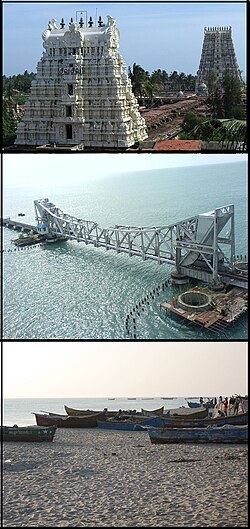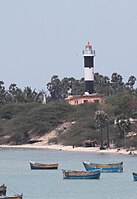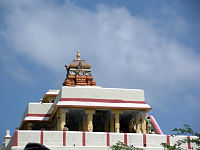Rameswaram (also spelt as Ramesvaram, Rameshwaram) is a town and municipality in the Ramanathapuram district of the Indian state of Tamil Nadu. It is on Pamban Island separated from mainland India by the Pamban channel and is about 40 kilometres from Mannar Island, Sri Lanka. It is in the Gulf of Mannar, at the tip of the Indian peninsula. Pamban Island, also known as Rameswaram Island, is connected to mainland India by the Pamban Bridge. Rameswaram is the terminus of the railway line from Chennai and Madurai. Together with Varanasi, it is considered to be one of the holiest places in India to Hindus, and part of the Char Dham pilgrimage.
It is written in the Ramayana that the Divine King Rama built a bridge with Hanuman's help from here across the sea to Lanka to rescue his wife Sita from her abductor Ravana. The Ramanathaswamy Temple, dedicated to the Vedic god Shiva, is at the centre of the town and is closely associated with Rama. The temple and the town are considered a holy pilgrimage site for Shaivas.
Rameswaram is the closest point from which to reach Sri Lanka from India, and geological evidence suggests that the Rama Sethu was a former land connection between India and Sri Lanka[citation needed]. The town has been in the news over the Sethusamudram Shipping Canal Project, Kachchatheevu, Sri Lankan Tamil refugees and capturing local fishermen for alleged cross-border activities by Sri Lankan Forces.[4] Rameswaram is administered by a municipality established in 1994. The town covers an area of 53 km2 (20 sq mi) and had a population of 44,856 as of 2011. Tourism and fishery employ the majority of workforce in Rameswaram.
It is written in the Ramayana that the Divine King Rama built a bridge with Hanuman's help from here across the sea to Lanka to rescue his wife Sita from her abductor Ravana. The Ramanathaswamy Temple, dedicated to the Vedic god Shiva, is at the centre of the town and is closely associated with Rama. The temple and the town are considered a holy pilgrimage site for Shaivas.
Rameswaram is the closest point from which to reach Sri Lanka from India, and geological evidence suggests that the Rama Sethu was a former land connection between India and Sri Lanka[citation needed]. The town has been in the news over the Sethusamudram Shipping Canal Project, Kachchatheevu, Sri Lankan Tamil refugees and capturing local fishermen for alleged cross-border activities by Sri Lankan Forces.[4] Rameswaram is administered by a municipality established in 1994. The town covers an area of 53 km2 (20 sq mi) and had a population of 44,856 as of 2011. Tourism and fishery employ the majority of workforce in Rameswaram.
Rameswaram
| |||||||||||||||||||||||||||||||||||||||||||
|---|---|---|---|---|---|---|---|---|---|---|---|---|---|---|---|---|---|---|---|---|---|---|---|---|---|---|---|---|---|---|---|---|---|---|---|---|---|---|---|---|---|---|---|
Town
| |||||||||||||||||||||||||||||||||||||||||||
 Rameswaram means "Lord of Rama" (Rāma-īśvaram) in Sanskrit, an epithet of Shiva, the presiding deity of the Ramanathaswamy Temple.According to one of the versions of Ramayana, Rama, the seventh avatar of the god Vishnu,
prayed to Shiva here to absolve any sins that he might have committed
during his war against the demon-king Ravana in Sri Lanka.[6][3] According to the Puranas (Hindu scriptures), upon the advice of sages, Rama along with his wife Sita and his brother Lakshmana, installed and worshipped the lingam (an iconic symbol of Shiva) here to expiate the sin of Brahmahatya incurred while killing of the Brahmin Ravana. To worship Shiva, Rama wanted to have a lingam and directed his trusted lieutenant Hanuman to bring it from Himalayas.[8][3]
Since it took longer to bring the lingam, Sita built a lingam, made of
just Sands of the shores, which is also believed to be the one in the
sanctum of the temple..Sethu
Karai is a place 22 km before the island of Rameswaram from where Rama
is believed to have built a floating stone bridge, the Ramsetu bridge,
that further continued to Dhanushkodi in Rameswaram till Talaimannar in
Sri Lanka.. According to another version, as quoted in Adhyatma Ramayana,
Rama installed the lingam before the construction of the bridge to
Lanka. However, both Valmiki and KambaRamayana does not have any
evidences about this Rameswaram story.(http://www.thehindu.com/opinion/letters/article2595588.ece) Rameswaram means "Lord of Rama" (Rāma-īśvaram) in Sanskrit, an epithet of Shiva, the presiding deity of the Ramanathaswamy Temple.According to one of the versions of Ramayana, Rama, the seventh avatar of the god Vishnu,
prayed to Shiva here to absolve any sins that he might have committed
during his war against the demon-king Ravana in Sri Lanka.[6][3] According to the Puranas (Hindu scriptures), upon the advice of sages, Rama along with his wife Sita and his brother Lakshmana, installed and worshipped the lingam (an iconic symbol of Shiva) here to expiate the sin of Brahmahatya incurred while killing of the Brahmin Ravana. To worship Shiva, Rama wanted to have a lingam and directed his trusted lieutenant Hanuman to bring it from Himalayas.[8][3]
Since it took longer to bring the lingam, Sita built a lingam, made of
just Sands of the shores, which is also believed to be the one in the
sanctum of the temple..Sethu
Karai is a place 22 km before the island of Rameswaram from where Rama
is believed to have built a floating stone bridge, the Ramsetu bridge,
that further continued to Dhanushkodi in Rameswaram till Talaimannar in
Sri Lanka.. According to another version, as quoted in Adhyatma Ramayana,
Rama installed the lingam before the construction of the bridge to
Lanka. However, both Valmiki and KambaRamayana does not have any
evidences about this Rameswaram story.(http://www.thehindu.com/opinion/letters/article2595588.ece)
From top: Ramanathaswamy Temple tower, Pamban Bridge, and a set of fishing boats.
| |||||||||||||||||||||||||||||||||||||||||||
| Nickname(s):
Rameswaram, Ramesvaram, Rameshwaram, ராமேஸ்வரம்
HistoryThe history of Rameswaram is centred around the island being a transit point to reach Sri Lanka (Ceylon historically) and the presence of Ramanathaswamy Temple. Tevaram, the 7th–8th century Tamil compositions on Shiva by the three prominent Nayanars (Saivites) namely Appar,[11] Sundarar and Thirugnanasambandar.[12] The Chola king Rajendra Chola I (1012 – 1040 CE) had a control of the town for a short period.[13] The Jaffna kingdom (1215–1624 CE) had close connections with the island and claimed the title Setukavalan meaning custodians of the Rameswaram.[14] Hinduism was their state religion and they made generous contribution to the temple.[14] Setu was used in their coins as well as in inscriptions as marker of the dynasty.[14]According to Firishta, Malik Kafur, the head general of Alauddin Khalji, the ruler of Delhi Sultanate, reached Rameswaram during his political campaign in spite of stiff resistance from the Pandyan princes in the early 14th century.[15][16][17] He erected a mosque by name Alia al-Din Khaldji in honour of victory of Islam.[15][16] During the early 15th century, the present day Ramanathapuram, Kamuthi and Rameswaram were included in the Pandya dynasty.[13] In 1520 CE, the town came under the rule of Vijayanagara Empire.[13] The Sethupathis, the breakaway from Madurai Nayaks, ruled Ramanathapuram and contributed to the Ramanathaswamy temple.[13][3] The most notable of them are the contributions of Muthu Kumara Ragunatha and Muthu Ramalinga Sethupathi, who transformed the temple to an architectural ensemble.[18] The region then fell under the rule of different leaders Chanda Sahib (1740 – 1754 CE), Arcot Nawab and Muhammed Yusuf Khan (1725 – 1764 CE) in the middle of the 18th century.[19] In 1795 CE, Rameswaram came under the direct control of the British East India Company and was annexed to the Madras Presidency. After 1947, the town became a part of Independent Indi Geography
An aerial view of Dhanushkodi, at the tip of Rameswaram
Ramsetu Bridge is a chain of limestone shoals, between Rameswaram and Mannar Island, off the northwestern coast of Sri Lanka. Geological evidence suggests that this bridge is a former land connection between India and Sri Lanka.[22] The bridge is 29 km (18 mi) long and separates the Gulf of Mannar (North-East) from the Palk Strait (South-West). It was reportedly passable on foot up to the 15th century until storms deepened the channel. The temple records record that Rama's Bridge was completely above sea level until it broke in a cyclone in 1480 CE.[23] The bridge was first mentioned in the ancient Indian Sanskrit epic Ramayana of Valmiki.[24] The name Rama's Bridge or Rama Setu (Sanskrit; setu: bridge) refers to the bridge built by the Vanara (ape men) army of Rama in Hindu mythology, which he used to reach Lanka and rescue his wife Sita from the demon king Ravana.[24] The Ramayana attributes the building of this bridge to Rama in verse 2-22-76, naming it as Setubandhanam.[25] The sea separating India and Sri Lanka is called Sethusamudram meaning "Sea of the Bridge". Maps prepared by a Dutch cartographer in 1747 CE, available at the Tanjore Saraswathi Mahal Library show this area as Ramancoil, a colloquial form of the Tamil Raman Kovil (or Rama's Temple).[26] Many other maps in Schwartzberg's historical atlas[27] and other sources such as travel texts by Marco Polo call this area by various names such as Adam's Bridge, Sethubandha and Sethubandha Rameswaram.[28] Demographics
As per the religious census of 2011, Rameswaram had 87.4% Hindus, 4.36% Muslims, 8.13% Christians, 0.03% Sikhs, 0.01% Buddhists, and 0.07% following other religions.[31] Municipal Administration and politics
A street in Rameswaram
Rameswaram comes under the Ramanathapuram assembly constituency and it elects a member to the Tamil Nadu Legislative Assembly once every five years.[41] The current MLA of the constituency is Dr. Manikandan from the AIADMK .[35] Rameswaram is a part of the Ramanathapuram (Lok Sabha constituency) – it has been realigned in 2008 to have the following assembly constituencies – Paramakudi (SC), Ramanathapuram, Mudukulathur, Aranthangi, Tiruchuli (newly created).[42] The constituency was traditionally a stronghold of the Indian National Congress that won 6 times till the 1991 elections, after which it was won twice each by the All India Anna Dravida Munnetra Kazhagam (ADMK) and the Dravida Munnetra Kazhagam (DMK). The current Member of Parliament from the constituency is A. Anwhar Raajhaa from the AIADMK party.[36]
Rameswaram Island Aerial view from Pamban Bridge
EconomyBeing a pilgrimage town, the majority of the population is involved in tourism related industry consisting of trade and services.[44] Service sector increased from 70% in 1971 to 98.78% in 2001, while the agricultural sector reduced from 23% in 1971 to 0.13% in 2001.[44] Rameswaram is an industrially backward town – there has been no demarcation for industrial land due to the pilgrim sanctity and ecological fragile geography.[44] Being an island town, the traditional occupation was fishing, but due to poor returns, the people in fishing community have gradually shifted to other professions.[44] Banks such as State Bank of India, Indian Bank and RDCC Bank have their branches in Rameswaram.[45]Transport and Communication
Road and rail bridge
Pamban lighthouse, Rameswaram
Rameswaram TV tower
Rameswaram is the important port among all the ports in the district, having a ferry service to Talaimannar of Sri Lanka, though not operational throughout the year.[51] Limited foreign trade is conducted with Jaffna, Kaits, Talaimannar and Colombo.[51] The Rameswaram TV Tower is the tallest tower in India.[54] The tower is a 323m tall circular concrete tower with a square steel mast of 45m height, diameter of 24m at the bottom tapering to 6.5m at top.[55] The tower has been designed for a wind velocity of 160 km/h.[55] There are two lighthouses in Rameswaram, the Pamban lighthouse and Rameswaram lighthouse.[56] Education and utility servicesRamanathapuram district has one of the lowest literacy rates in the state of Tamil Nadu and Rameswaram, following the district statistics has a lower literacy rate. There are a couple of Government high schools, one each for boys and girls.[57] There are seven other schools namely, Swami. Vivekananda vidyalaya Matriculation School( which provide excellent education in the island and secure district and state level ranks in board exams frequently), St. Joseph Higher Secondary School, Mandapam Panchayat Union 9 – School, Micro Matriculation School, Sri Sankara Vidhyalaya, Holy Island Little Flower School and Kendriya Vidhyalaya School.[57] Alagappa University Evening College is the only college present in the town[58] and all the nearest colleges are located in Ramanathapuram and Paramakudi.[59][58]Electricity supply to the town is regulated and distributed by the Ramanathapuram circle of Tamil Nadu Electricity Board (TNEB).[60] Water supply is provided by the Rameswaram Municipality – the head works is located at Nambunayaki Amman Kovil, Meyyambuli, Semmamadam & Natarajapuram and distributed through four over head tanks having a total capacity of 1430,000 litres.[61] About 6 metric tonnes of solid waste are collected from the town every day in the four zones covering the whole of the town.[62] Rameswaram does not have a sewerage system for disposal of sullage and the disposal system consists of septic tanks and public conveniences.[63] Roadside drains carry untreated sewage out of the town to let out raw into the sea or accumulates in low-lying area.[63] Rameswaram comes under the Karaikudi Telecom circle of the Bharat Sanchar Nigam Limited (BSNL), India's state-owned telecom and internet services provider. Apart from telecom, BSNL also provides broadband internet service[64] along with other major internet service provider like Reliance.[65] ReligionBeing a Hindu pilgrimage centre, Hindus form the visitor base of the city. There is a minority of Christians belonging to the fishing community. C.S.I island mission church and St Antony's Church at Oriyur on the eastern shore of the island are prominent Churches in the island.[49]Ramanathaswamy Temple
Corridor of 1000 pillars
Temple Tanks
Kothandaramar Temple, Rameswaram
Gandhamathana ParvathamGandhamathan Parvatham, a hillock situated 3 km to the north of the temple is the highest point in the island.[68] There is a two storeyed hall, where Rama's feet is found as an imprint on a chakra (wheel).[68] The Ramarpatham Temple is located on the hillock.[68]DhanushkodiDhanushkodi is the southernmost tip of the island and houses the Kothandaramaswamy Temple dedicated to Rama.[68] Though Dhanushkodi was washed away during the 1964 cyclone, the temple alone remained intact. It is 18 km way from the centre of the town and can be reached by road. A popular belief is that, Dhanushkodi is where Vibishana, a brother of Ravana surrendered before Rama in the epic Ramayana.[68]Hindu Pilgrimage
People taking a holy dip in Agni theerth, Bay of Bengal
Interaction with Sri LankaRameswaram is frequently in headlines over fishermen issues like attack, arrest and alleged harassment by Sri Lankan navy for alleged cross border activities, Sethusamudram canal project, Kachchatheevu, Sri Lankan Tamil refugees and also on intercountry smuggling between India and Sri Lanka.[4] As an initial step to curb enhanced smuggling, the Tamil Nadu government has set up 30 more marine police stations to bring the state's entire coastal belt under close vigil.[4]Sri Lankan Tamil RefugeesDuring the intense civil war of Sri Lanka, post 1980, Rameswaram acted as one of the focal points of smuggling and intense patrolling was carried out during the period.[75] There are a total of 65,940 registered destitute Sri Lankan refugees dwelling in 129 Refugee camps situated in different parts of Tamil Nadu as of Apr 2000 and a majority of them enter via Rameswaram.[76] There are an additional 20,667 non-camp refugees who entered via Rameswaram, registered in Mandapam transit camp and opted to reside outside the camps in various parts of Tamil Nadu.[76] On 11 March 1990, a record number of 2,337 refugees in 38 boats arrived from Talaimannar in Sri Lanka to Rameswaram – this was the largest number of refugees arriving in a single day since the ethnic violence from July 1983.[77] As of October 2006, an estimated 200,000 refugees have been reported in Mandapam Camp.[78] Sivarasan, one of the mastermind behind the Assassination of Rajiv Gandhi, the ex-prime minister of India registered as refugee in Rameswaram camp on 12 September 1990.[79]Rameswaram Fishery
Fishing boats in Rameswaram
There is a yearly 45-day ban on fishery with motorboats in the region.[83] The fishing ban for the year 2012 was effective during the months of April–May.[83][84] The jetty at Rameswaram is the largest landing centre for fishing boats in the region and it usually comes alive after the ban, with the arrival of fishermen, boat captains, shore workers and others from their native places.[84] Sea World Aquarium is a natural habitat lying opposite to the Rameswaram Bus Stand, having an assortment of underwater creatures – it is the only one of its kind in the state, filled with such varied marine life forms including exotic species.[49] Kachchatheevu
NASA satellite photo: Rameswaram on top, Sri Lanka at the bottom of the photo
Sethusamudram Canal ProjectSethusamudram Shipping Canal Project proposes linking the Palk Bay and the Gulf of Mannar between India and Sri Lanka by creating a shipping canal through the shallow sea sometimes called Setu Samudram, and through the chain of islands variously known as Ram Sethu or the Rama's Bridge. A few organisations are opposing the dredging of Ramasethu on religious, environmental and economical grounds. Many of these parties and organisations support implementation of this project using one of the five alternative alignments considered earlier[88] without damaging the structure considered sacred by Hindus. With 22 km (14 mi) of dredging remaining, the project is held from March 2010 by a Supreme Court order seeking the Central Government to clarify the status of the bridge as a national monumen | |||||||||||||||||||||||||||||||||||||||||||











No comments:
Post a Comment